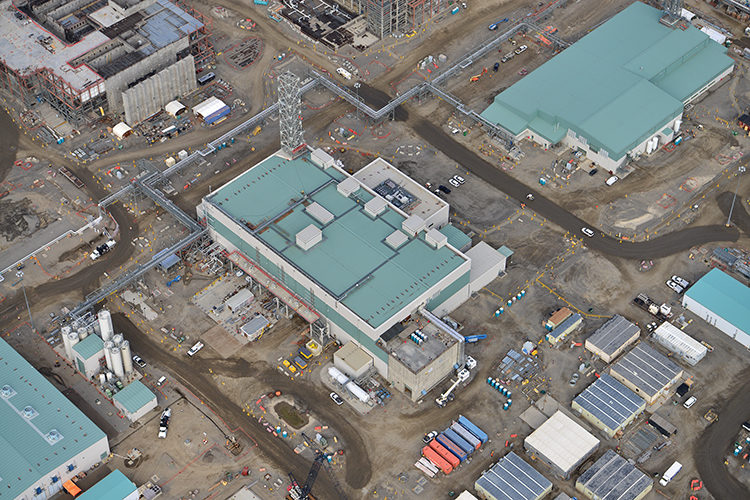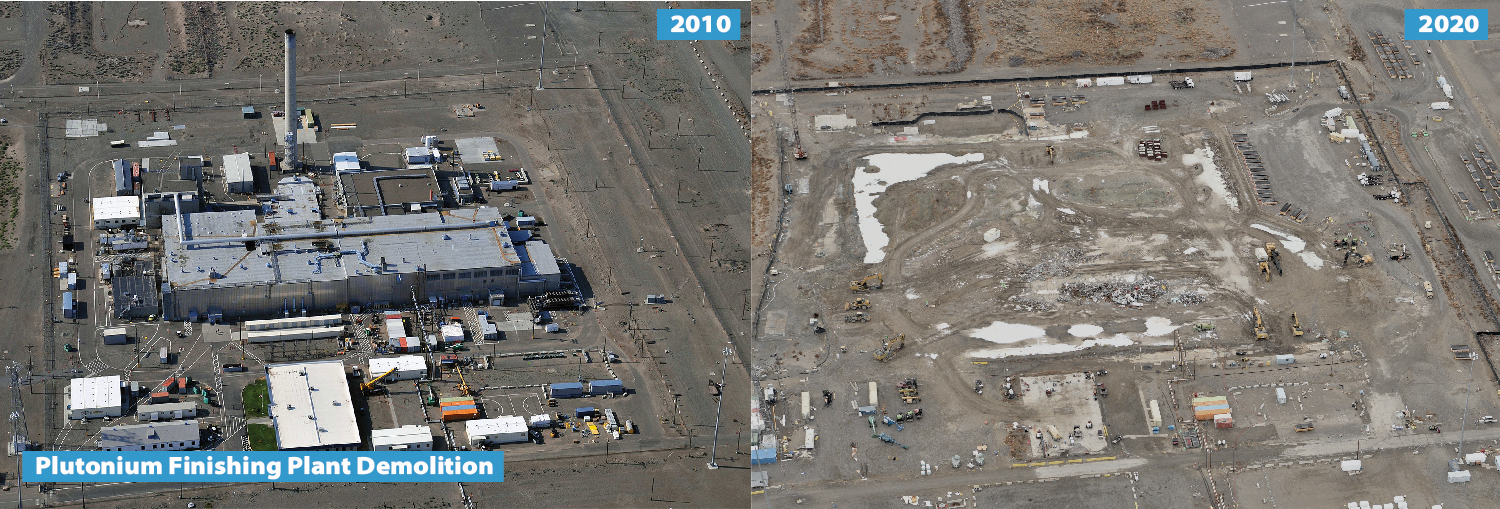
Home » New construction, demolition, waste treatment mark signs of progress
New construction, demolition, waste treatment mark signs of progress

April 15, 2020
Hanford’s major contractors continue to make significant achievements at the site, including demolitions, new construction and wastewater treatment as part of ongoing cleanup efforts.
A major accomplishment was celebrated in winter 2020 with the demolition of the Plutonium Finishing Plant’s main processing facility, a result of work by CH2M HILL Plateau Remediation Co. (CHPRC). The project 20 years in the making now includes work to remove rubble, safely test soil and cover building slabs.
Progress on the Bechtel National-built Low-Activity Waste (LAW) Facility has continued with the opening of the facility’s annex, as well as completion of the startup and testing phases of more than 90 percent of the systems within it. The annex includes a control room.
Future waste retrieval will be assisted by Direct-Feed Low-Activity Waste (DFLAW) systems, designed to treat 5 million to 7 million gallons of waste yearly through the Effluent Treatment Facility.
Seventy percent of the DFLAW systems have been turned over to the startup phase at the future site of the world’s largest radioactive treatment facility, the Waste Treatment and Immobilization Plant, known as the vit plant, also under construction by Bechtel.
At the start of the cleanup in 1989, nothing existed that could treat underground tank waste. And just one method existed to retrieve waste from the tanks successfully. Now, 18 technologies exist and waste has been retrieved from 18 tanks, with one more underway.
At the onset of cleanup, 177 underground tanks held dangerous waste, with 67 presumed to have leaked. The original 56 million gallons of waste have now been reduced or transferred to double-shell tanks, designed to hold the waste more securely.
Clearing the waste will be aided by the $17 billion plant, which Bechtel recently closed out the design phase for, including completion of all startup and testing activities in the areas described as the “backbone” of the plant. This includes structures that are part of the project. The contractor is working toward a goal of processing low-activity waste by 2023.
In recent months, radioactive sludge held at the K West Reactor was successfully transferred to T Plant for interim storage, an accomplishment that came three months ahead of schedule for a milestone memorialized in the Tri-Party Agreement, a contract outlining cleanup deadlines at the site. When the 35 cubic yards of highly radioactive sludge were fully relocated to the new plant through efforts by CHPRC, Hanford site Manager Brian Vance of the U.S. Department of Energy called the project a “critical step” on the path to reduce Hanford’s annual operating costs, which top $2 billion yearly.
Since cleanup began, the Department of Energy also can tout overall accomplishments in terms of millions and billions when referring to the amount of soil removed and water treated within the Hanford area. This includes 18.5 million tons of soil or debris moved from 2,000 waste sites to a landfill designed to receive the contaminated material, as well as 22 billion gallons of groundwater treated.
In addition, one billion gallons of contaminated groundwater were treated in the first five months of fiscal year 2019. This accomplishment by CHPRC helped the contractor get more than halfway to its goal of 1.8 billion gallons treated for the full year.

Cleaning the groundwater has resulted in more than 577 tons of contamination removed from a scope of more than 100 square miles at the site. Since operations began in 2012 at Hanford’s largest groundwater treatment site, the 200 West Pump and Treat Facility, CHPRC workers removed one million pounds of nitrate from the groundwater. The contractor points to cost-savings efforts at the same facility for recently reducing expenses to their lowest per-gallon amount since 2013.
Additionally, the Effluent Treatment Facility far exceeded its goal of treating wastewater received from the Liquid Effluent Retention Facility. Expected to treat two million gallons of wastewater in a year’s time, removing radioactive and hazardous contaminants, the facility actually treated 3.4 million gallons instead.
Hanford waste intended for vitrification must first be evaluated. This will happen at the Analytical Laboratory, part of the vit plant site constructed by Bechtel.
In recent months, it was a big step to move chemists and scientific instrumentation into the laboratory to begin developing methods to evaluate samples. Bechtel also completed construction of all major portions of the Effluent Management Facility, which allowed the Hanford contractor to begin testing systems.
Over time, DOE contractors have moved all spent fuel into dry storage, which includes 2,300 tons near the Columbia River. In addition, 20 tons of leftover plutonium was stabilized and shipped off site.
In late summer 2019, CHPRC finished design work to move radioactive capsules into dry storage. This is considered a safer means of storage for the nearly 2,000 cesium and strontium capsules that have been sitting underwater since the 1970s. The capsules will eventually be stored at the Waste Encapsulation Storage Facility, once complete.
Last spring, crews from CHPRC successfully stabilized PUREX Tunnel 2, which had been at risk of collapsing. The tunnel is one of two that were used to transport waste off the Hanford site using railcars. Both tunnels still contain cars with contaminated equipment aboard. After PUREX Tunnel 1 partially collapsed three years ago, the urgency of stabilizing the second tunnel was heightened. It required 40,000 cubic yards of engineered grout to complete the safety upgrade.
When Hanford remediation began more than 30 years ago, there was a 586-square-mile footprint of active cleanup. Since that time, just 76 square miles are still on the to-do list. Of the original 1,705 total facilities and 2,025 waste sites, 905 facilities have been demolished and 1,353 waste sites remediated.
The Department of Energy says, “Nowhere in the DOE Complex is cleanup more challenging than at the Hanford site,” due to its production of more than 20 million pieces of uranium metal fuel for the nine nuclear reactors that once operated in the region. Of those nine original plutonium production reactors, six were cocooned, or encased in cement and steel, to prevent any residual radiation from contaminating the environment. Nearby facilities associated with the reactors were demolished and one reactor was preserved. The B Reactor is now part of the Manhattan Project National Historical Park and welcomes tourists.
The decades-long cleanup process that began with the Tri-Party Agreement included 161 milestones for cleanup that were agreed upon by DOE, Environmental Protection Agency and the state of Washington in 1989.
Since then, 1,734 milestones and target dates were added to the original list. Of that number, 1,691 were considered complete as of January 2020.
Hanford
KEYWORDS april 2020




